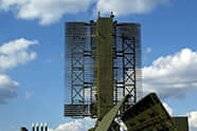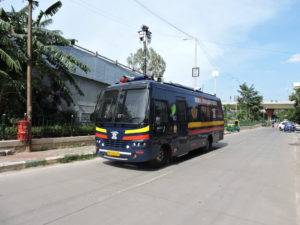Introduction
Many video surveillance applications today are IP based, and use the internet to allow remote users to access the video feed. The increasing use of video surveillance means that some surveillance areas are not connected on the Internet, through a LAN or a wired IP backbone: ports, city surveillance, mobile surveillance, remote medical services, etc. In order to cater to surveillance requirements in such non-wired IP backbone locations, system integrators are looking at various wireless connectivity solutions that can provide the connection between the IP surveillance set-up and users.
| Wireless Broadband | |||||||
| |||||||
| Satellite Transmission | |||||||
| 3G Data card |
Wireless Broadband
Wireless broadband networks provide Internet access to sites and locations that are not otherwise connected on a wired IP backbone. There are three principal wireless architectures, which are explained below.
Wireless broadband is significantly more expensive than wired broadband, and the bandwidth will not be of the size available on wired IP backbones; but it is a practical solution for sites and locations that are not very far from a wired IP backbone or for mobile sites.
Point-to-Point Wireless Broadband
Point-to-Point wireless broadband links are typically available in the 5.4, 5.8 and 5.9 GHz spectrum. They offer high-performance connectivity and backhaul in challenging Non-Line-of-Sight (NLoS) environments and are ideal for backhaul applications between two points. They offer data rates up to 300 Mbps and can reach a distance of up to 200 kilometers. This is an ideal connectivity solution for applications where multiple, high-bandwidth video streams need to be transmitted between two points.
Point-to-Multipoint Wireless Broadband
Point-to-multipoint wireless broadband links operate in the 5.4 GHz and 5.8 GHz frequency bands. They are usually equipped with OFDM tech¬nology to deliver outstanding throughput, long-range and Line-of-Sight (LoS) and near-Line-of-Sight (nLoS) performance for reliable and secure data, voice and video connectivity. The point-to-multipoint wireless broadband provides approximately 40 Mbps of total aggregate throughput to difficult-to-reach locations, and provides ranges of up to 40 kms. This is an ideal connectivity solution for applications where a user needs to communicate from multiple remote sites or locations, to one central point.
Mesh Network Wireless Broadband
A wireless mesh network is made up of multiple wireless routers organized in a mesh topology. Wireless mesh network solutions are available in the 2.4 GHz and 4.9 GHz band for licensed and public network operations, respectively. A mesh network is highly redundant and secure. When one node is temporarily disabled, the rest of the nodes still communicate and provide alternate modes of connectivity. The mesh network is ideal for applications needing continuous, on-the-move connectivity like mobile applications, video streaming to public transport, police and emergency services vehicles for increased productivity and improved safety.
Satellite Transmission
VSAT (Very Small Aperture Terminal) networks use satellite transmission to establish a communication link. Therefore, they can get near-broadband access from essentially anywhere in the world. Users can chose between setting up a personal VSAT hub to manage their streaming requirements or opt for a value-added service provided by the VSAT vendor. Current VSAT services available in the market provide an uplink of up to a maximum of 2 Mbps. A VSAT network is ideal for video surveillance applications where other connectivity options are not feasible, because of distance or LoS issues, and where the bandwidth requirement is not very high.
3G Data Card
A 3G data card is the least expensive option for remote connectivity, especially in mobile surveillance applications; where data needs to be transferred on the move. The latest 3G cards available in the market provide up to 3 Mbps bandwidth; which makes it easy to transmit video streams of acceptable resolution (D1 quality). The only limitation here is that this bandwidth is limited to specific cities, and when the connectivity goes beyond the defined city limits the bandwidth available reduces to 115Mbps; which is very low for a video surveillance application.
Conclusion
There are multiple remote connectivity options available in the market today and users can opt for one or a combination of them, based on the application, quality of the video feed and distance over which the video streams needs to be transmitted.



